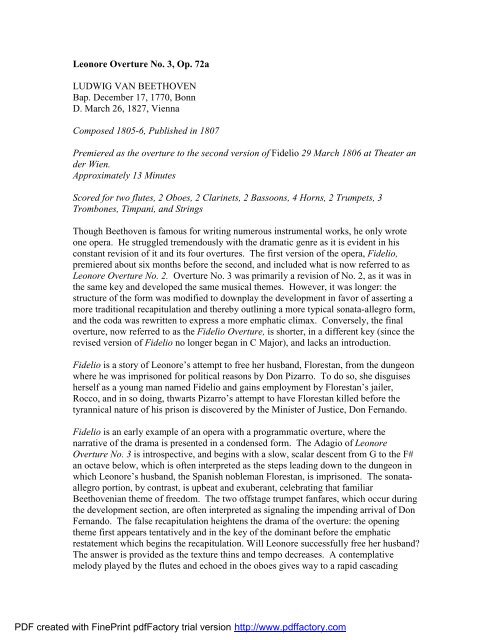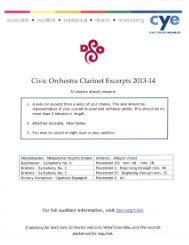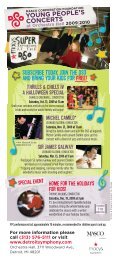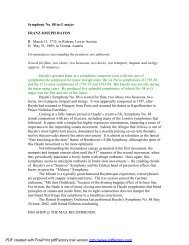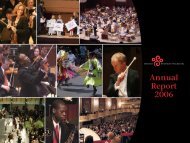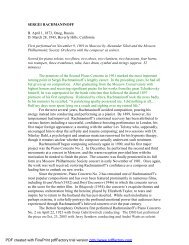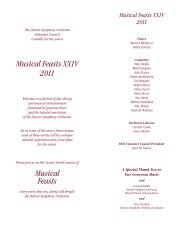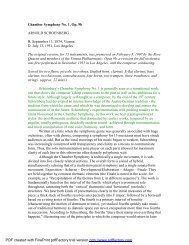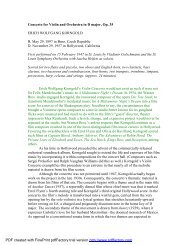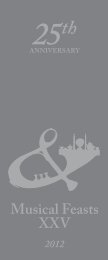Leonore Overture No. 3, Op. 72a LUDWIG VAN BEETHOVEN Bap ...
Leonore Overture No. 3, Op. 72a LUDWIG VAN BEETHOVEN Bap ...
Leonore Overture No. 3, Op. 72a LUDWIG VAN BEETHOVEN Bap ...
You also want an ePaper? Increase the reach of your titles
YUMPU automatically turns print PDFs into web optimized ePapers that Google loves.
<strong>Leonore</strong> <strong>Overture</strong> <strong>No</strong>. 3, <strong>Op</strong>. <strong>72a</strong><br />
<strong>LUDWIG</strong> <strong>VAN</strong> <strong>BEETHOVEN</strong><br />
<strong>Bap</strong>. December 17, 1770, Bonn<br />
D. March 26, 1827, Vienna<br />
Composed 1805-6, Published in 1807<br />
Premiered as the overture to the second version of Fidelio 29 March 1806 at Theater an<br />
der Wien.<br />
Approximately 13 Minutes<br />
Scored for two flutes, 2 Oboes, 2 Clarinets, 2 Bassoons, 4 Horns, 2 Trumpets, 3<br />
Trombones, Timpani, and Strings<br />
Though Beethoven is famous for writing numerous instrumental works, he only wrote<br />
one opera. He struggled tremendously with the dramatic genre as it is evident in his<br />
constant revision of it and its four overtures. The first version of the opera, Fidelio,<br />
premiered about six months before the second, and included what is now referred to as<br />
<strong>Leonore</strong> <strong>Overture</strong> <strong>No</strong>. 2. <strong>Overture</strong> <strong>No</strong>. 3 was primarily a revision of <strong>No</strong>. 2, as it was in<br />
the same key and developed the same musical themes. However, it was longer: the<br />
structure of the form was modified to downplay the development in favor of asserting a<br />
more traditional recapitulation and thereby outlining a more typical sonata-allegro form,<br />
and the coda was rewritten to express a more emphatic climax. Conversely, the final<br />
overture, now referred to as the Fidelio <strong>Overture</strong>, is shorter, in a different key (since the<br />
revised version of Fidelio no longer began in C Major), and lacks an introduction.<br />
Fidelio is a story of <strong>Leonore</strong>’s attempt to free her husband, Florestan, from the dungeon<br />
where he was imprisoned for political reasons by Don Pizarro. To do so, she disguises<br />
herself as a young man named Fidelio and gains employment by Florestan’s jailer,<br />
Rocco, and in so doing, thwarts Pizarro’s attempt to have Florestan killed before the<br />
tyrannical nature of his prison is discovered by the Minister of Justice, Don Fernando.<br />
Fidelio is an early example of an opera with a programmatic overture, where the<br />
narrative of the drama is presented in a condensed form. The Adagio of <strong>Leonore</strong><br />
<strong>Overture</strong> <strong>No</strong>. 3 is introspective, and begins with a slow, scalar descent from G to the F#<br />
an octave below, which is often interpreted as the steps leading down to the dungeon in<br />
which <strong>Leonore</strong>’s husband, the Spanish nobleman Florestan, is imprisoned. The sonataallegro<br />
portion, by contrast, is upbeat and exuberant, celebrating that familiar<br />
Beethovenian theme of freedom. The two offstage trumpet fanfares, which occur during<br />
the development section, are often interpreted as signaling the impending arrival of Don<br />
Fernando. The false recapitulation heightens the drama of the overture: the opening<br />
theme first appears tentatively and in the key of the dominant before the emphatic<br />
restatement which begins the recapitulation. Will <strong>Leonore</strong> successfully free her husband<br />
The answer is provided as the texture thins and tempo decreases. A contemplative<br />
melody played by the flutes and echoed in the oboes gives way to a rapid cascading<br />
PDF created with FinePrint pdfFactory trial version http://www.pdffactory.com
crescendo in the violins which drives the piece to its exuberant closing, referencing the<br />
joy of Florestan’s freedom and the reuniting of the lovers.<br />
<strong>Leonore</strong> <strong>No</strong>. 3 is most commonly performed in orchestral settings, apart from Fidelio as<br />
it is this evening. However, it occasionally finds its way into the opera before the last<br />
scene of the second act, a practice started by Gustav Mahler which is still considered to<br />
be somewhat controversial.<br />
Program note by Steven M. Reale.<br />
PDF created with FinePrint pdfFactory trial version http://www.pdffactory.com


